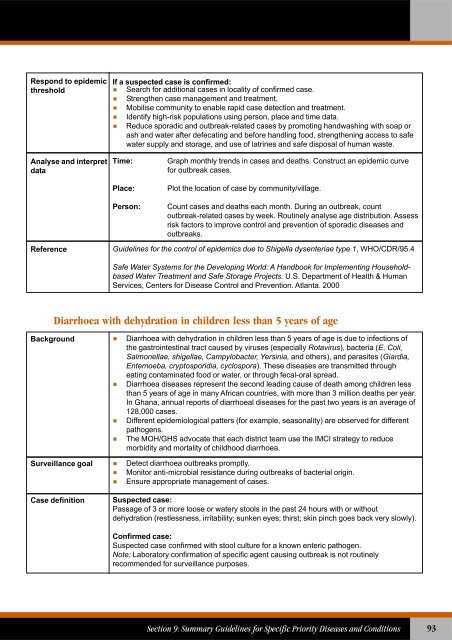Technical Guidelines for Integrated Disease Surveillance ... - PHRplus
Technical Guidelines for Integrated Disease Surveillance ... - PHRplus
Technical Guidelines for Integrated Disease Surveillance ... - PHRplus
You also want an ePaper? Increase the reach of your titles
YUMPU automatically turns print PDFs into web optimized ePapers that Google loves.
Respond to epidemicthresholdIf a suspected case is confirmed: Search <strong>for</strong> additional cases in locality of confirmed case. Strengthen case management and treatment. Mobilise community to enable rapid case detection and treatment. Identify high-risk populations using person, place and time data. Reduce sporadic and outbreak-related cases by promoting handwashing with soap orash and water after defecating and be<strong>for</strong>e handling food, strengthening access to safewater supply and storage, and use of latrines and safe disposal of human waste.Analyse and interpretdataTime:Place:Person:Graph monthly trends in cases and deaths. Construct an epidemic curve<strong>for</strong> outbreak cases.Plot the location of case by community/village.Count cases and deaths each month. During an outbreak, countoutbreak-related cases by week. Routinely analyse age distribution. Assessrisk factors to improve control and prevention of sporadic diseases andoutbreaks.Reference<strong>Guidelines</strong> <strong>for</strong> the control of epidemics due to Shigella dysenteriae type 1, WHO/CDR/95.4Safe Water Systems <strong>for</strong> the Developing World: A Handbook <strong>for</strong> Implementing HouseholdbasedWater Treatment and Safe Storage Projects. U.S. Department of Health & HumanServices, Centers <strong>for</strong> <strong>Disease</strong> Control and Prevention. Atlanta. 2000Diarrhoea with dehydration in children less than 5 years of ageBackground Diarrhoea with dehydration in children less than 5 years of age is due to infections ofthe gastrointestinal tract caused by viruses (especially Rotavirus), bacteria (E. Coli,Salmonellae, shigellae, Campylobacter, Yersinia, and others), and parasites (Giardia,Entemoeba, cryptosporidia, cyclospora). These diseases are transmitted througheating contaminated food or water, or through fecal-oral spread. Diarrhoea diseases represent the second leading cause of death among children lessthan 5 years of age in many African countries, with more than 3 million deaths per year.In Ghana, annual reports of diarrhoeal diseases <strong>for</strong> the past two years is an average of128,000 cases. Different epidemiological patters (<strong>for</strong> example, seasonality) are observed <strong>for</strong> differentpathogens. The MOH/GHS advocate that each district team use the IMCI strategy to reducemorbidity and mortality of childhood diarrhoea.<strong>Surveillance</strong> goal Detect diarrhoea outbreaks promptly. Monitor anti-microbial resistance during outbreaks of bacterial origin.Ensure appropriate management of cases.Case definitionSuspected case:Passage of 3 or more loose or watery stools in the past 24 hours with or withoutdehydration (restlessness, irritability; sunken eyes; thirst; skin pinch goes back very slowly).Confirmed case:Suspected case confirmed with stool culture <strong>for</strong> a known enteric pathogen.Note: Laboratory confirmation of specific agent causing outbreak is not routinelyrecommended <strong>for</strong> surveillance purposes.Section 9: Summary <strong>Guidelines</strong> <strong>for</strong> Specific Priority <strong>Disease</strong>s and Conditions93















